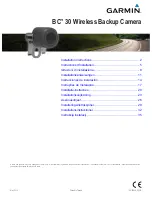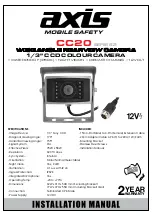
12
You can now check the area covered by the camera in its current position. Make movements in front of the camera at several positions within the area
where you expect the game or subjects to be. Try different distances and angles from the camera.
The results of your testing will help you find the best placement when mounting and aiming the Impulse Camera. The height away from the ground for
placing the device should vary with the animal size appropriately. In general, 3 to 6 feet is preferred.
You can avoid potential false triggers due to temperature and motion disturbances in front of the camera by not aiming it at a heat source or nearby tree
branches or brush (especially on windy days).
USING AN EXTERNAL POWER SOURCE (optional, user provided)
Optionally, you can connect the #119756C Accessory Solar Panel (please visit
www.bushnell.com
for more information) to the “DC In” jack at the bottom
of the Impulse camera (other external power supplies should not be used, as the camera and/or display may not function correctly). If the solar panel is
connected and AA batteries are installed, the Impulse camera will be powered by the solar panel’s rechargeable lith-ion battery, as long as it provides
adequate voltage (if not, the camera will switch to battery power). The solar panel’s battery will power the camera at night. Nominal output of the
119756C solar panel is 8.4V.
VIEWING THE PHOTOS/VIDEOS
After you have setup, mounted and activated your Impulse camera, you will of course be eager to review the images it has captured for you. There are
two different ways to do this:
1) Reviewing Images Remotely via Website/Apps
Please refer to the “BASIC SETUP STEPS” section at the front of this manual for details on how to download and use our smartphone application.
2) Reviewing Images Directly From the SD Card
Since unmounting the camera and taking it to your computer isn’t very convenient, you may find it easier to just take the card out. By removing the
SD card (swapping it for a new empty card if you like) and taking it to your home or campsite to view the images by using an SD card “reader” (user
supplied) connected to your computer (some computers and TVs have a built in SD card slot), you can leave the camera in place ready to capture more
images. Once connected, the card reader works the same way as described below-please read that section if you have any problem finding your files.
When using an SD card reader with a PC (or Mac*) to view photos (or video clips*), first connect the device to the computer (a cable may or may not be
provided with the card reader). Then use commercial software with an image browser feature, or an image browser included with the PC’s operating
system to view images saved on the SD card in the folder DCIM. Each new image or video will be numbered incrementally in order of the time it was
captured. For example, you will see file names such as “WTC20_0001.jpg” or “WTC20_0001mp4, etc. Through the file format suffix you can distinguish
whether the file is a still photo (with suffix .jpg) or a video (with suffix .mp4). You will also see a “Thumbs” directory-this holds images yet to be sent to
the server.
*video files may require additional software for viewing on a Mac.
The Impulse Camera supports 3 kinds of file system formats, FAT12, FAT16, and FAT32. The default value is FAT16 to save photos and videos. Here are some
related notes:
You don’t need to be concerned about the file system format of the Impulse Camera unless your equipment has problems reading the SD card. If this
happens, please format the SD card with the Impulse Camera or in your computer first and then insert the card into your Impulse Camera and try again.
The default file system format of the Impulse Camera is FAT16, which most computers can read. If you format an SD card for the Impulse Camera in your
computer, you should choose the file system format FAT16. Normally FAT16 is recommended unless you have another image viewer that uses FAT12 or
FAT32 format.








































